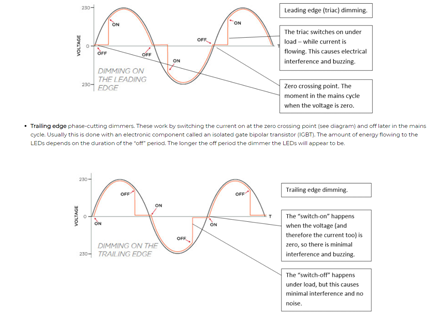LED Dimmers - A Complete Guide
LED Dimmers
In today's world of lighting, LED technology has revolutionized the way we illuminate our homes and spaces. Alongside this innovation, LED dimmers have emerged as the perfect companions, allowing us to adjust the brightness of our lights to create the desired ambiance. In this comprehensive guide, we will delve into the world of LED dimmers, exploring different dimming technologies, types, sizes, and their fascinating history. So, let's embark on this illuminating journey together!
Dimming Technologies Explained
Dimming technology has come a long way, adapting to the unique requirements of LED lighting. Here, we will explore three common dimming technologies:
-
Phase Dimming - Phase dimming, also known as leading-edge dimming, is the traditional dimming method used with incandescent bulbs. It works by cutting off a portion of the voltage waveform, resulting in reduced brightness. However, phase dimming is not always compatible with LEDs, as they have different electrical characteristics. Some LED bulbs may flicker or have limited dimming range when used with phase dimmers.
-
Triac Dimming - Triac dimming, a variant of phase dimming, overcomes the limitations of traditional phase dimmers. It uses a more advanced electronic switch called a triode for alternating current (TRIAC), which improves compatibility with LED bulbs. Triac dimmers are widely available and offer smooth dimming performance.
-
PWM Dimming - Pulse-width modulation (PWM) dimming is a digital dimming technique that rapidly switches LEDs on and off. By varying the duration of on and off states, the average brightness of the LED is adjusted. PWM dimming provides excellent dimming range, compatibility, and flicker-free performance, making it ideal for LED lighting.

Exploring Different Types and Sizes of LED Dimmers
LED dimmers come in various types and sizes, designed to cater to different installation requirements and control options. Let's discover the most common ones:
-
Wall Mounted Dimmers - Wall-mounted dimmers are the most popular and easily recognizable dimmers. They are installed on the wall and feature a rotary knob, slide switch, or touch control to adjust brightness. These dimmers offer convenient control and are available in a range of designs to suit different aesthetics.
-
Remote Control Dimmers - For added flexibility, remote control dimmers allow you to adjust lighting levels from anywhere within range. They come with a handheld remote that communicates wirelessly with the dimmer, providing convenience and ease of use.
-
Touchpad Dimmers - Touchpad dimmers offer a sleek and modern approach to lighting control. They feature a touch-sensitive surface, allowing you to swipe or tap to adjust brightness. Touchpad dimmers are user-friendly, and some models even offer additional features like preset lighting scenes.
-
Smart Dimmers - Smart dimmers are the cutting-edge of lighting control. These dimmers connect to your home network and can be controlled through a smartphone app or voice commands, thanks to compatibility with virtual assistants like Amazon Alexa or Google Assistant. They offer advanced scheduling, automation, and integration with other smart home devices.
-
Built In Dimmers - Built-in dimmers are integrated into specific LED light fixtures, offering a seamless and compact solution. These dimmers are ideal for retrofitting existing fixtures or for new installations where space is limited.

A Glimpse into the History of Dimming
Dimming has a rich history that dates back to the early days of incandescent lighting. In the late 19th century, dimming involved manually adjusting the intensity of gas and carbon arc lamps using various mechanical means. As incandescent bulbs gained popularity, resistance dimming emerged, allowing users to adjust brightness using variable resistors.
With the advent of semiconductor technology, electronic dimmers evolved, offering improved efficiency and performance. Early electronic dimmers utilized phase-cutting techniques, which later paved the way for TRIAC dimming. As LED lighting gained prominence, the need for dimmers compatible with this technology became apparent, leading to the development of PWM dimming and improved compatibility with existing dimming technologies.

Shedding Light on LED Dimming Questions
Why do some dimmers not work with LEDs?
LED dimming compatibility depends on the specific dimming technology used. Some older dimmers, designed for incandescent or halogen bulbs, may not be compatible with the unique electrical characteristics of LEDs. It's essential to choose dimmers explicitly labeled as compatible with LED lighting to ensure optimal performance.
Why are dimmable LED bulbs so expensive?
Dimmable LED bulbs often cost more than non-dimmable ones due to the additional components required for dimming functionality. These components, such as drivers or controllers, contribute to the overall cost of the bulb. However, the price of dimmable LED bulbs has been decreasing over time as LED technology becomes more widespread.
What happens if you put a non-dimmable LED bulb in a dimmer?
If a non-dimmable LED bulb is used with a dimmer, it may flicker, emit buzzing sounds, or even be damaged. Non-dimmable LED bulbs are designed to operate at full brightness and do not contain the necessary circuitry to handle dimming signals. It's crucial to use dimmable LED bulbs with compatible dimmers for proper operation.
Why do LED bulbs flicker on dimmer?
LED bulbs can flicker on a dimmer for several reasons. Incompatibility between the dimmer and the LED bulb, inadequate dimming range, or using a non-dimmable bulb can cause flickering. Additionally, the quality of the dimmer and the LED bulb, as well as the overall wiring setup, can also contribute to flickering issues.
How do I stop my LED lights from flickering when dimmed?
To prevent LED lights from flickering when dimmed, follow these steps: a. Ensure you are using dimmable LED bulbs specifically designed for dimming applications. b. Use dimmers labeled as compatible with LED lighting. c. Ensure the total wattage of the LED bulbs connected to the dimmer is within the dimmer's specified range. Consider upgrading to a higher-quality dimmer if flickering persists.
Why do LED lights buzz when dimmed?
LED lights can buzz when dimmed due to a phenomenon called electromagnetic interference (EMI). EMI can occur when the dimmer switch's electrical components generate vibrations or hum at certain dimming levels. Upgrading to a higher-quality dimmer and ensuring proper grounding and wiring can help reduce buzzing noises.
Can I use my old dimmer switch with LED bulbs?
It depends on the specific dimmer and LED bulb compatibility. Older dimmer switches designed for incandescent bulbs may not work correctly with LED bulbs, resulting in flickering or limited dimming range. It's advisable to consult the dimmer manufacturer's specifications or opt for dimmers explicitly labeled as compatible with LED lighting.
How do I know if my LED bulbs are dimmable?
Dimmable LED bulbs are typically labeled as such on the packaging or product description. Look for the "dimmable" symbol or check the manufacturer's specifications. If unsure, consult the retailer or manufacturer for clarification.
Do dimmers require different wiring?
In most cases, dimmers do not require different wiring. However, certain dimmers, such as some smart dimmers, may require additional wiring connections to enable advanced features or communication with other devices. When replacing a dimmer, it's essential to follow the manufacturer's installation instructions and consult a qualified electrician if needed.
By addressing these frequently asked questions, we aim to provide you with a comprehensive understanding of LED dimmers and their compatibility with LED bulbs, as well as solutions to common issues that may arise during the dimming process. Enjoy the flexibility and control that LED dimmers bring to your lighting experience!
LED Dimming Conclusion
LED dimmers are the magical devices that empower us to control the brightness of our lighting, creating the perfect ambiance for every occasion. Whether you prefer the classic wall-mounted dimmer or seek the convenience of smart dimmers, there's a solution to meet your needs. By understanding the different dimming technologies and exploring the various types and sizes available, you can make an informed decision when selecting an LED dimmer that suits your requirements. Embrace the beauty of adjustable lighting and let LED dimmers illuminate your space in harmony with your mood and style.
See our full range of LED Dimmers & Modules Here!

